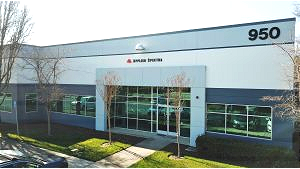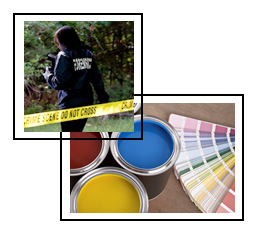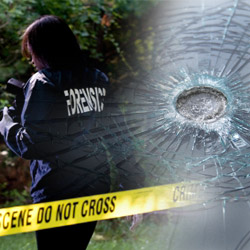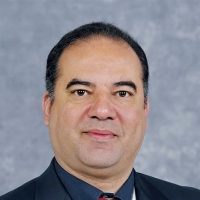The Tool for Forensic Analysis
Application Notes
Elemental Mapping of Printed Ink Using the J200 Tandem LA – LIBS Instrument In Combination
with ICP-MS
The J200 Tandem LA-LIBS instrument from Applied Spectra, Inc. provides the unique capability of combining the analytical benefits of both LA-ICP-MS (Laser Ablation-Inductively Coupled Plasma-Mass Spectrometry) and LIBS (Laser Induced Breakdown Spectroscopy). Specifically, LIBS provides greater elemental coverage from H – Pu, including elements that are difficult or impossible by conventional ICP-MS instrument such as non-metals (e.g. H, N, O), and halogens (e.g. F). When coupled with a
sensitive ICP-MS instrument, the J200 Tandem can perform quantitative and qualitative measurements focusing on trace level elements and their isotopic ratio analyses. This instrument, in combination with an ICP-MS, expands the dynamic range of analysis from ppb (or the absolute detection limits of the ICPMS), to % levels with LIBS.
Building Confidence for Forensic Glass Analysis with Applied Spectra’s J200 LIBS
Glass fragments are one important type of forensic trace evidence that can help to link an individual or vehicle to the scene of a crime. The forensic analyst needs a reliable means of matching questioned glass fragments to a known source. Glass fragments as trace evidence are analyzed in a number of ways. Physical properties of glass such as color, thickness, shape, or texture can be investigated visually as a first screening. Refractive index (RI) also has been used as a technique for matching glass fragments to known sources. However, RI alone can fail to differentiate certain glass types. For instance, float and container glass exhibit refractive index values that are extremely similar, although these two glasses have very different chemical compositions. Also, vast improvements in sheet glass manufacturing processes have made investigation of physical properties and RI measurement less effective in differentiating very similar glass fragments for forensic purposes.
Discrimination of Paint Samples by
Laser Induced Breakdown Spectroscopy (LIBS)
A crime scene can provide valuable information to an investigation as to what may have taken place. Despite the prevalence of DNA analysis, trace evidence can build a solid foundation for solving the case. Trace evidence cases include items such as glass, hair, fibers, paints, and polymers. Trace evidence can help establish links between people, objects, and places.The case presented here will look at the ability to determine if the elemental profile of the paint recovered from a suspect’s vehicle is indistinguishable to the paint samples recovered from a crime scene. Blue paint samples were obtained from the suspect’s vehicle, a guard rail, and from a traffic sign.
TESTIMONIALS
DR. JOSE ALMIRALL
Dr. Jose Almirall – Florida International University
José R. Almirall served as a practicing forensic scientist at the Miami-Dade Police Department Crime Laboratory before his academic appointment at FIU in 1998. In addition to authoring a book and about 145 peer-reviewed scientific publications in the field of analytical and forensic chemistry, Prof. Almirall has received six U.S. patents and serves on several national forensic science boards.
Email: almirall@fiu.edu
DR. TATIANA TREJOS
Dr. Tatiana Trejos – West Virginia University
Dr. Trejos joined the faculty of the Department of Forensic & Investigative Science at WVU in the fall of 2016. Dr. Trejos earned a B.S. degree in Chemistry from the University of Costa Rica, an M.S. degree in Forensic Science from Florida International University and a Ph.D. in Chemistry/Forensic from Florida International University. She spent 11 years as researcher and manager of the Trace Evidence Analysis Facility at the International Forensic Research Institute at Florida International University. Since 2014, Dr. Trejos was appointed IFRI faculty and Director of the Professional Science Master in Forensic Sciences at FIU. Before joining FIU, Dr. Trejos was a forensic chemist at the Department of Forensic Science/ Supreme Court of Justice of Costa Rica.
Email: tatiana.trejos@mail.wvu.edu
About our Company
At the Forefront of Elemental Chemical Analysis
Applied Spectra, Inc. is the leader in laser ablation-based elemental analysis. Our world-class scientific and engineering teams have developed a suite of analytical instruments to simplify the process of elemental analysis.
Let the Laser do the sampling.
Laser sampling delivers rapid, accurate and high precision results that are environmentally friendly – a compelling value proposition over acid dissolution methods which are time consuming and generate chemical waste products.

Transforming Laser Technology
Applied Spectra delivers products based on two analytical technologies: LIBS (Laser Induced Breakdown Spectroscopy) and LA-ICP-MS ( Laser Ablation-Inductively Coupled Plasma-Mass Spectrometry).
Corporate Background
Applied Spectra Inc. was founded in 2004 by Dr. Richard E. Russo at the Lawrence Berkeley National Laboratory. As a pioneer in R&D of laser ablation for chemical analysis, Dr Russo advanced LA-ICP-MS and LIBS for 32 plus years with 60+ million dollar funding support and more than 300 manuscripts. Based on in-depth knowledge of laser ablation and technology from his Berkeley research, Applied Spectra began its operation as the technology spin-off company to commercialize laser ablation instruments.
Today, Applied Spectra is the leading manufacturer of state-of-the art LIBS and LA instruments. Our company is proud to have the largest installed base of commercial benchtop LIBS instruments in the world. Applied Spectra developed the first commercially successful femtosecond LA instrument based on Ytterbium diode pumped technology. We developed the innovative and powerful Tandem LA-LIBS instrument to combine LIBS and LA-ICP-MS capabilities into one platform. Our customer base is global with instrument distribution in over 55 countries.











